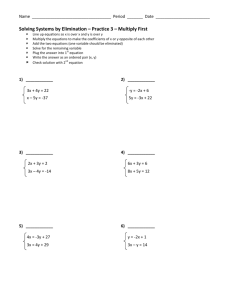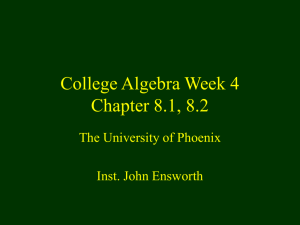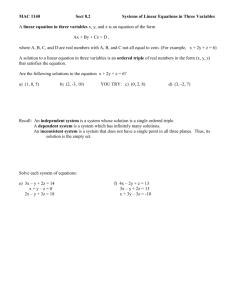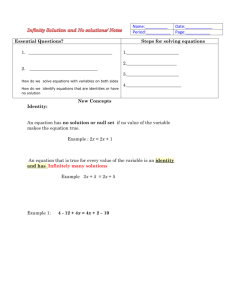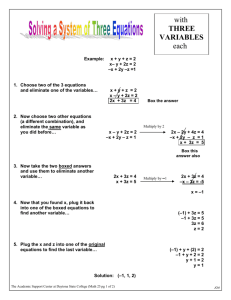College Algebra Week 4 Chapter 8.1, 8.2
advertisement
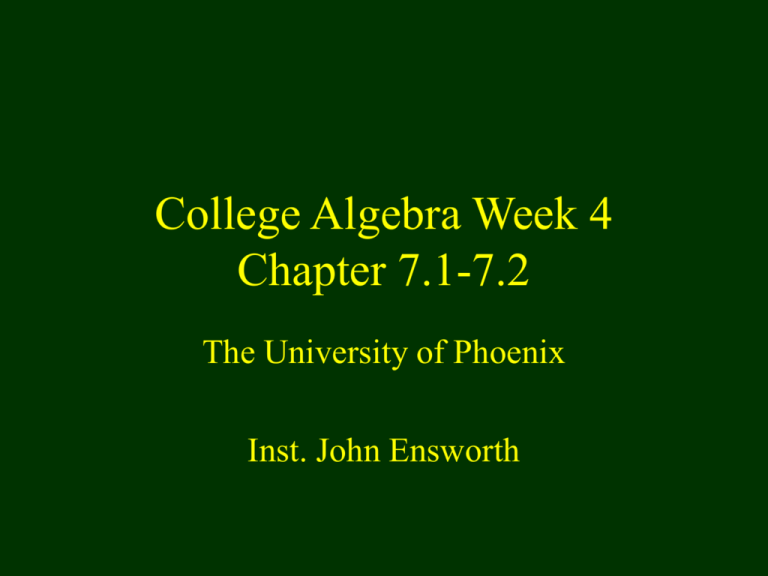
College Algebra Week 4
Chapter 7.1-7.2
The University of Phoenix
Inst. John Ensworth
Short section – 7.1 to 7.2
• In these two sections, we work a bit more
with situations where we have two
equations.
• We want to find if and where they meet!
• We want to know what (x,y) they share.
• This is LIKE our overlapping shading, but
we’re just looking for one point!
Section 7.1 Graphing and
Substituting to find that special
(x,y)
• We’ll take two equations, graph them and
see where they cross…
Example 1 A system with only
one solution pg452
•
•
•
•
•
•
y=x+2 done… m=1 and (0,2)
x+y=4 y=-x+4 m=-1 and (0,4)
Plot it!
It looks like
(1,3)
Let’s check it!
Checking Example 1
• (1,3) Plug into the original equations
• y=x+2
x+y=4
• 3=1+2 AND 1+3=4
• 3=3
AND
4=4
• Both at the same time and both right!
• GREAT!
**Examples 7-14**
Example 2 – Infinite Solutions
pg 453
2(y+2)=x
x-2y=4
Solve for y (y=mx+b form)
2y+4=x
x-2y=4
2y=x-4
-2y=-x+4
y=1/2 x –2
y=1/2 x –2
The same slope (1/2) and y-intercept (0,-2)!
Example 2
• Plotting:
**Examples 15-16**
Example 3 another graphing
pg 453
•
•
•
•
•
•
2x-3y=6
and
3y-2x=3
Get that y=mx+b form!
-3y=-2x+6
and
3y=2x+3
y=2/3 x –2
and
x= 2/3 y +1
Giving us graph fodder…
=2/3 and (0,-2)
and m=2/3 and (0,1)
Example 3 the graph
• Oh oh!
• No answer
• Null Set
**Examples 17-20**
Definitions!
• So we say we have a system of equations that are
independent, inconsistent or dependent based on
how many solutions there are.
Solving an independent system
by substitution
Example 4 page 455
y=2x-3
y=x+5 plug this x+5 in for y in the 1st equation
2x-3=x+5
x-3=5
x=8 plug into one of the above equations
y=8+5=13 plugging into the other y=2(8)-3=13
Check!
**Examples 35-46**
A quicker method
• The graphing method we’ve used is clunky.
You have to make a graph every time.
What if the answer is 8.394349 ? Can you
read the graph THAT closely?
• So we’ll try another method… we’ll use the
“Substitution Method”
• (There must be some substituting of some
sort going on here!)
Example 5 Independent system
solved by substitution pg455
• 2x+3y=8
• y+2x=6 solve for y y=-2x+6
• Notice that the second equation tells us
what y equals. Why not stick it INTO the y
in the first equation?
• Are we crazy enough to do THAT?
Ex 5 Substituting
•
•
•
•
•
•
•
2x+3y=8
y=-2x+6
2x+3(-2x+6)=8
2x-6x+18=8
-4x+18=8
-4x=-10
x= 5/2 we have half of the answer, what is y?
Ex 5 finding y
• Since x= 5/2 we can use our second equation
y= -2x+6
y= -2(5/2) +6 = -5+6 = 1 So we have (5/2,1)
• Check it!
• 2(5/2) + 3(1) = 8
and 1=-2(5/2)+6
• 5+3 = 8
and 1=-6+6 = 1
• Check
and
Check!
**Examples 47-52**
Ex 6 A dependent system solved
by substitution
(all numbers = answers) pg 456
• 2x+3y=5+x+4y
• y=x-5
• We have y ready to use so plug it into the first
equation
• 2x + 3(x-5) = 5+x+4(x-5)
• 2x+3x-15=5+x+4x-20
• 5x-15=5x-15 Oh, oh, they are the SAME! All
answers work! It’s dependent.
• **Examples 53-54**
Ex 7 How about substituting and
finding an inconsistent solution
(no answer)? Pg 456
•
•
•
•
•
•
•
•
x-2y=3
2x-4y=7
It’s easiest to solve for x in the first equation
x= 2y+3
Now stick that into the second equation
2(2y+3)-4y=7
4y+6-4y = 7
6=7 BUZZ! It crashed and burned, it’s inconsistent.
The cookbook…
Ex 8 An application page 457
• Let’s say we have a swimming pool who’s
rectangular length is 2X it’s width. If the
perimeter is 120 feet, what is it’s Length (L)
and Width (W)
•
•
•
•
•
•
•
•
Ex 8 continued
It told us:
L=2W
And 2L+2W=120
Here we go… we have L so stick it into the
second equation
2(2W)+2W=120
4W+2W=120
6W=120
W=20 feet. That means (using the first
equation) L=2(W) or 2(20) or 40 L=40 feet.
**Examples 79-90**
Ex 9 Application - Investments
• Belinda had $20,000 to invest. She invested
part at 10% and the rest at 20%. Her
income was $2160. How much did she
invest in both?
• Summary
Amount
Rate
Interest
First
X
investment
10%
0.10x
Second
Y
investment
12%
0.12y
Ex 9 continued
• x+y=20000
• 0.10x+0.12y=2160
• We’ll solve the first equation for x for simplicity
x=20000-y then stick it into the second equation…
• 0.10(20000-y) + 0.12y = 2160
• 2000 –0.1y +0.12y = 2160
• 0.02y = 2160
• y=8000 then plug that into the first
x+8000=20000 means x=12,000
• So she invested $12,000 at 10% and $8000 at 12%
Exercises 7.1
•
•
•
•
•
•
•
Here we go again!
Definitions Q 1-6
Solve by graphing Q7-20
Match graphs to system of equations Q21-24
Graphing with a calculator Q25-34
Solve using the substitution method Q35-78
Application problems Q79-108
Section 7.2 the last of Algebra I
• Now we’ll keep solving systems of linear
equations, but using a new trick.
• This one keeps you from having to
substitute big nasty expressions
• We eliminate a variable by adding or
subtracting the two equations just right.
The Addition Method
•
•
•
•
Example 1 page 464
3x-5y = -9
4x+5y=23
Notice that if you added –5y to 5y, they kill
each other!
The addition method continued
3x-5y = -9
+ 4x+5y= 23
________________
7x + 0 = 14
solve 7x=14
x=2
Getting y now in the addition
method (Ex 1 continued)
• We know x=2 so plug it into EITHER original
equation!
• 3x-5y = -9
4x+5y=23
• 3(2)-5y = -9
4(2) +5y=23
• 6-5y = -9
8 +5y = 23
• -5y = -15
5y=15
• y=3
y=3
• It worked both ways! So the solution is {(2,3)}
**Examples 7-14**
Example 2 pg 465: What if the
equations don’t help us… make
them help us!
• 2x-3y = -13
• 5x-12y=-46
• Nothing will vanish if we add or subtract
these two equations.
• So let’s MAKE them cancel somehow.
• Look at the y’s if the first equation were
multiplied on both sides by –4, what would
happen?
Example 2 continued
•
•
•
•
•
•
2x-3y = -13
5x-12y=-46
So step one is multiply the first eq. by –4
(-4)2x-(-4)3y=(-4)(-13)
-8x+12y=52
Now well add them
-8x+12y=52
+ 5x –12y=-46
________________
-3x + 0y = 6
x= -2
Example 2 getting y
•
•
•
•
•
•
•
We know x=-2
Plug it into either of the first equations again and get X
2x-3y=-13
2(-2) –3y=-13
-4 –3y = -13
-3y=-9
y=3
So (-2,3) is IT!
• If you want, you can plug it into either or both of the
starting equations and check it. We’ll go on though…
**Examples 15-18**
Example 3 Multiplying BOTH to
make things nice pg 456
(Use your LCD brain cells)
• -2x+3y=6
• 3x- 5y = -11
• There are no simple (smaller) numbers we
can multiply ONE equation by to make it
easily add or subtract from the other.
• But what if we multiplied the first by 3 and
the second by –2 ???
Example 3 continued
•
•
•
•
•
•
Doing two at once…
3(-2x+3y) = 3(6)
2(3x-5y) = 2(-11)
The next step – simplify
-6x+9y=18
6x-10y=-22 Hey! We’re ready!
Example 3 doing the addition
-6x+9y=18
+
6x-10y=-22
________________
0x –y = -4
so y=4
Plug that into one of the original equations…
-2x+3(4)=6 -2x +12=6 -2x =-6 x=3
• So the (3,4) **Examples 19-24**
Example 4 Here is one with
inconsistent equations page 466
2x-3y=9 copy
6y=4x-18 reorder
2x-3y=9
Multiply by 2
-4x+6y=-18
4x-6y= 18
+ -4x+6y=-18 It looks EASY!
________________
0 = 0 BONK!
Example 4b Here is one with
inconsistent equations page 466
-4y = 5x + 7
+ 4y = -5x + 12 It is EASY!
________________
0 = 0x + 19
0 = 19 BONK!!
**Examples 25-30**
Example 5 pg 467 – We can do the same
thing with fractions and decimals!
• ½ x – 2/3 y = 7
• 2/3x – ¾ y = 11
• What can we do? We want something to cancel.
We want to turn the fractions in front of either both
x’s or both y’s into integers.
(We’re using all the early tools!)
• How about multiplying 6 to the first (making 1/x
into 3x) and 12 to the second
(making 2/3x into 8x)?
Example 5 continued
•
•
•
•
•
6[ 1/2x – 2/3y] = 6(7)
12[ 2/3x – 3/4y] = 12(11)
Working both
3x- 4y = 42
8x-9y = 132 nice, everything became an
integer
• NOW can we kill something … lets keep
hitting on the x’s
Example 5 continued
• 3x- 4y = 42
• 8x-9y = 132
•
•
•
•
•
Let’s multiply both
equations by the other
equation’s coefficient of x
-8(3x-4y) = -8(42) note I stuck in a – sign for ease
3(8x-9y) = 3(132)
Multiply them out…
-24x+32y=-336
24x – 27y= 396
Example 5 adding
-24x+32y=-336
+ 24x–27y= 396
___________________
0x +5y = 60
y=12
Plug y=12 into one of our original equations to get x
½ x – 2/3(12) = 7 ½ x-8=7 ½ x = 15
x= 30 Our answer is (30,12)
**Examples 31-38**
Example 6 pg 467– now with
decimals
0.05x+0.7y=40
x+0.4y=120
So we’ll kill the decimals by multiplying the
first by 100 and the second by 10
100[0.05x+0.7y]=[40]100
10[x+0.4y]=[120]10
Multiply out and onto the next slide…
Ex 6 continued
5x+70y=4000
10x+4y=120
If we multiply the first by –2 we’ll kill the x’s
-10x-140y=-8000
10x + 4y= 120
-136y=-6800 y=50 plug into
x+0.4y=120 x+0.4(50)=120 x=100
**Examples 39-46**
{100,50}
The Addition Method Cookbook
Example 7 Applications page 468
• At a café the price for 4 fajita dinners and 3
burrito dinners is $48 . The total price for 3
fajita dinners and 2 burrito dinners is $34.
What is the price for each dinner?
• 4x+3y=48
• 3x+2y=34
Example 7 continued
4x+3y=48
3x+2y=34
multiply both by the
other equation’s x
coefficient (to kill the x’s)
-3(4x+3y) = -3(48) make it – for ease
4(3x+2y) = 4(34)
Multiply this out on the next frame…
Example 7 adding!
-12-9y = -144
+ 12x+8y = 136
-----------------------------0x –y = -8
so y=8
Plug that into 4x+3(8) = 48
4x+24=48 4x=24 x=6
So you have (6,8) as the solution!
Fajita dinners cost $6, Burritos cost $8.
**Examples 65-70**
Example 8 page 469
• Working with mixing oils, we know the
following:
%fat
Canola Oil
Amount of
oil
X
7
Amount of
fat
0.07x
Corn Oil
Y
14
0.14y
Canola and
Corn Oil
280
11
0.11(280)
which is 30.8
gallons
Example 8
• x+y = 280 (total amounts of oil)
• 0.07x+0.14y = 30.8 (amounts of fat)
What if we multiply the FIRST equation by
-0.07 we get
-0.07x -0.07y = -19.6
0.07x+0.14y = 30.8
Example 8 – to the end
-0.07x -0.07y = -19.6
+
0.07x+0.14y = 30.8
_________________________
0x + 0.07 y = 11.2
So y=11.2/0.07 = 160
Using the first equation we put y =160 in to get x
x+160=280 x=120
It takes 120 gal. of canola and 160 gal. of corn oil to make
Crisco Canola and Corn Oil **Examples 65-70**
Exercises 7.2
•
•
•
•
•
Definitions Q1 – Q6
Solve using the addition method Q7-30
Using fractions and/or decimals Q31-46
Practice mix bag Q47-64
Application Q65-87
